You may not find this terribly rewarding unless you're included here, so this is a good time for casual and random browsers to turn back before they get too caught up in the sweep and majesty of the proceedings and can't let go.
The Museo e Real Bosco di Capodimonte ('museum and royal forest') sits in the Reggia or royal palace of Capodimonte, at the top of the hill, as its name suggests, overlooking the city of Naples.
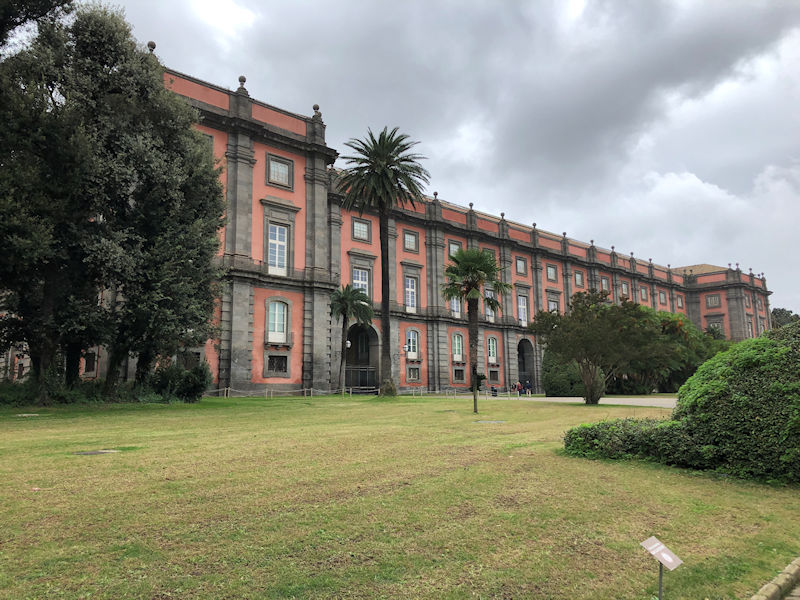
The art collections are well presented in this vast palace, built for King Charles VII of Naples and Sicily (and later King of Spain) when in 1738 his court outgrew his then-palace, but mostly because he'd inherited the so-called 'Farnese Collection' from his mother, the last descendant of the Farnese Dukes of Parma, and needed some place to show it all off. By 1758, the palace was completed and the art works were brought in.
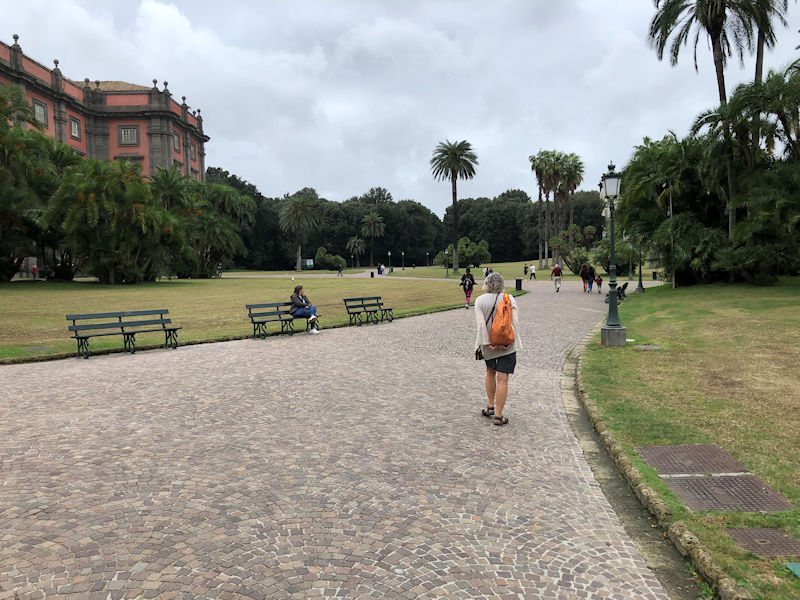
When the French army took over here in 1799, they looted much of it, but during their 10-year occupation much of it was brought back and, when the French departed in 1815, the palace was renovated. Under Austrian control and after 1861 under the Savoy royal house of independent Italy, many notable additions were made to the holdings. In 1920 the palace came into the ownership of the state, and in 1950 it became a national museum, inaugurated in 1957.
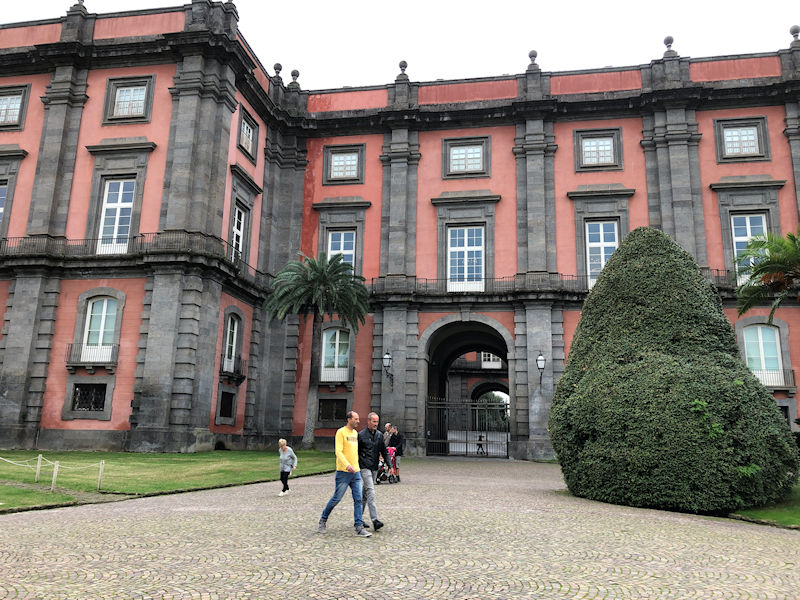
We've visited before and posted here a few of our favorite photos from that trip, so this time, 27 October 2023, we may be trying to conquer new rooms unseen the first time (except for the Joachim Beuckelaer corridor) and see what comes out of that.

So where to begin?
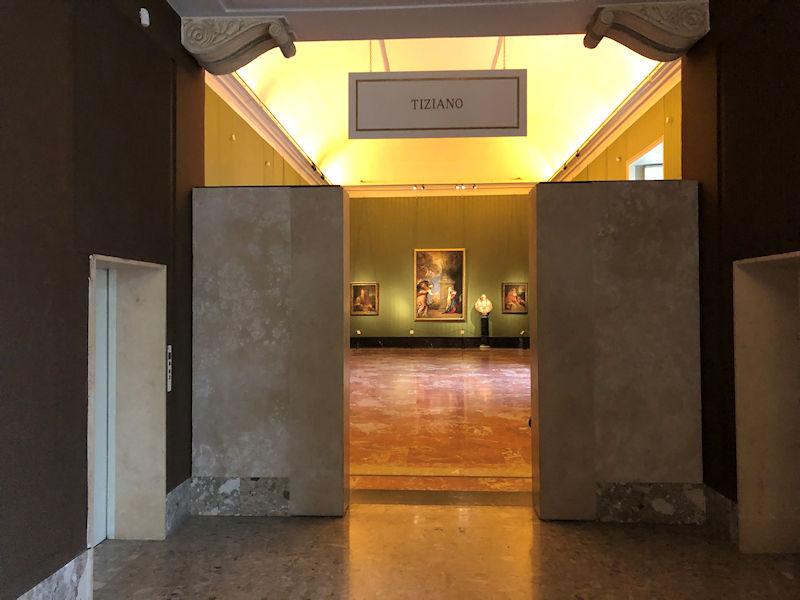
We've wandered up past the Titian rooms, and where better to get a running start.
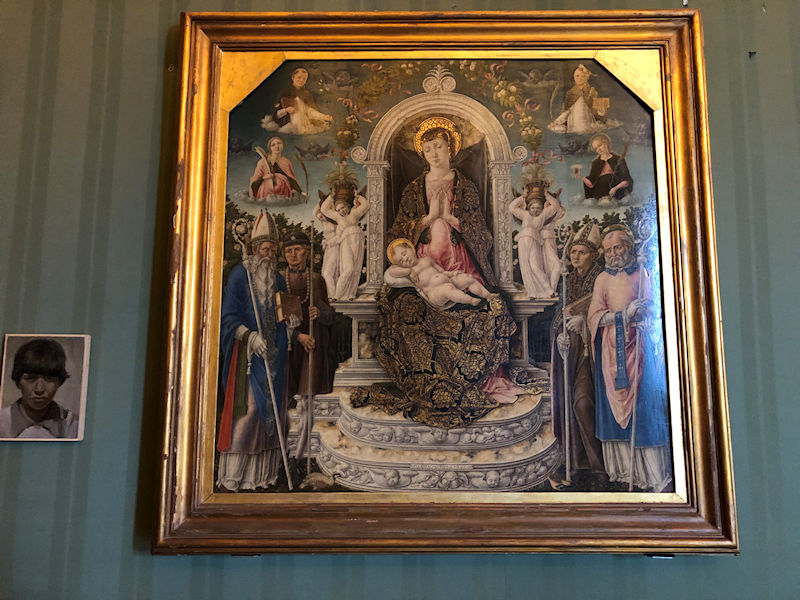
Only that's certainly not a Titian. It's labeled as by Bartolomeo Vivaraini (ca.1432-post 1491), dated to 1465: Mother and Child and a large number of saints, including in the far upper right Peter Martyr with the cleaver in his head and Mary Magdalene with her ointment jar just below him.
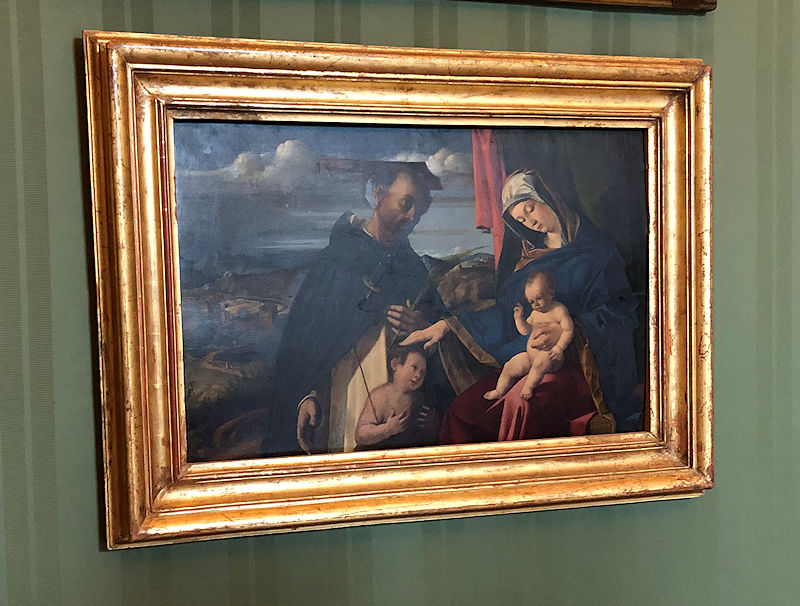
There's that nice Peter Martyr again, with his ominous head-cleaver and a soulful look, and a conventional mother and baby scene, by Lorenzo Lotto (1480-1556), dated 1503.
St Peter Martyr of Verona, a capable persecutor of Cathar heretics, a Dominican agent of the Inquisition, in fact, was assassinated in 1252 with an axe in the head by a brute named Carino, hired by a consortium of northern Italian Cathars. He was able, as his last act, to write out the Apostle's Creed on the ground with his blood. During his life he frequently conversed with dead saints, all of whom had been virgin martyrs. Carino repented and became a Dominican himself.

Now here we go. This is a 1543 Titian portrait of Pierluigi Farnese, a brutal mercenary commander and illegitimate son of Pope Paul III, who in 1545 handed Piacenza and Parma over to him
as Duke; he was assassinated by an irate populace two years later.
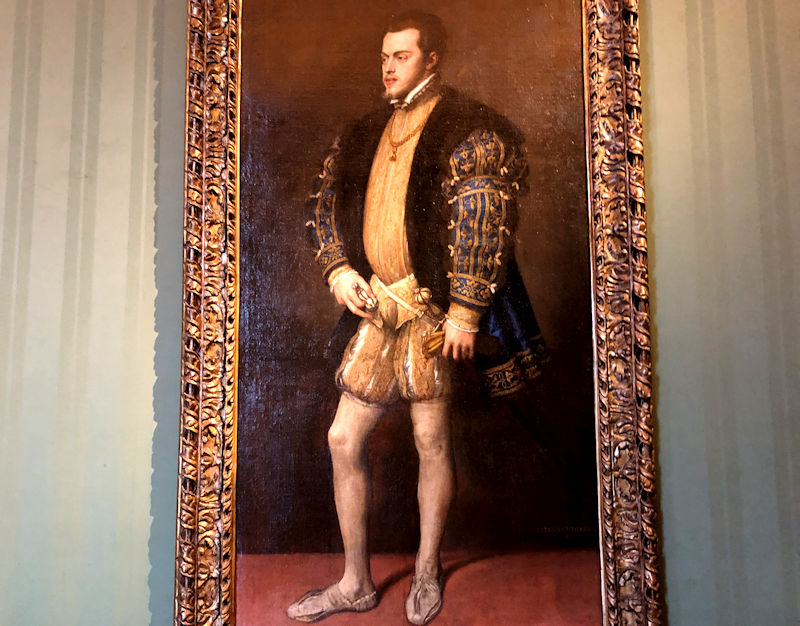
Here's Titian's version of Spain's King Philip II, dated to ca. 1554 (the same year his father the Emperor Charles V married him off to Queen Mary I of England). The famous Habsburg lower jaw of later inbred generations is already beginning to show itself.
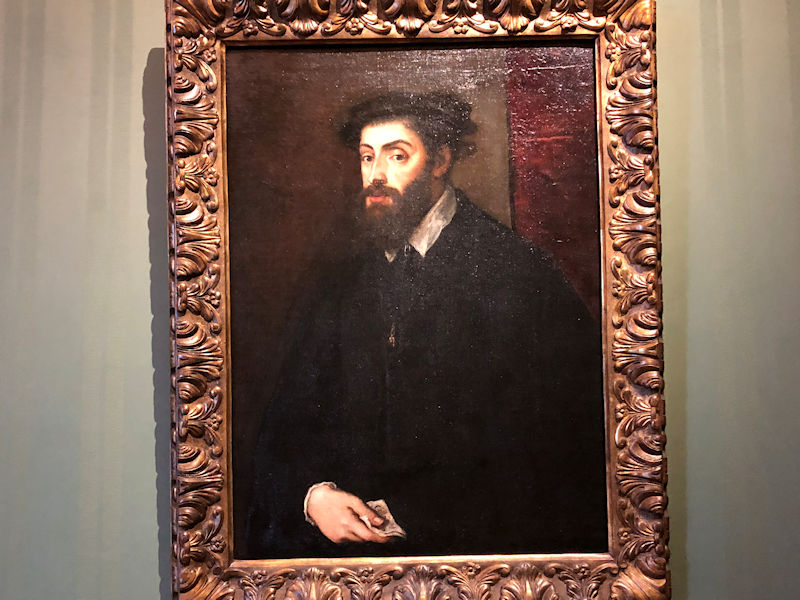
Speaking of Charles V, that's him, in 1549, or at least Titian's take on him.
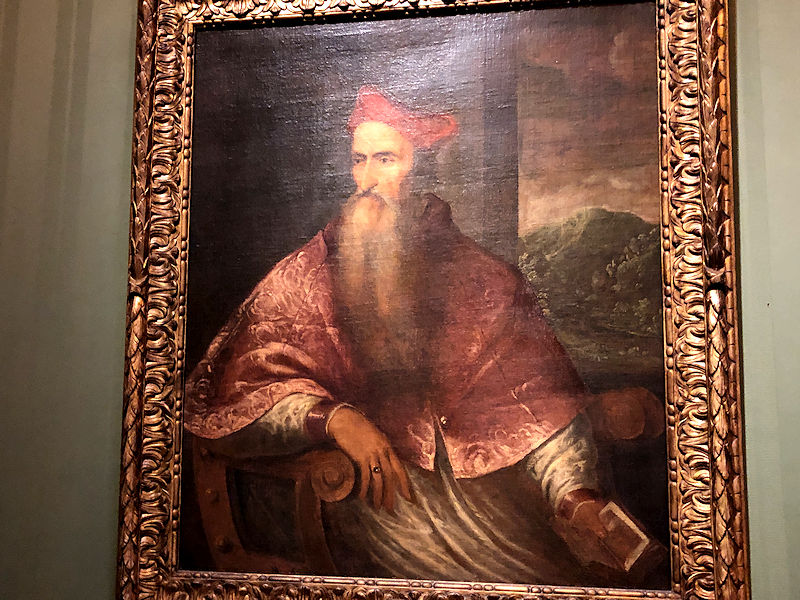
And this is a classic. That's one of our favorite Renaissance-era humanists, Pietro Bembo (1470-1547), the Italian scholar, linguist, philosopher, poet, lover of Lucrezia Borgia the Duchess of Ferrara in his youth and a close friend afterward, and a major force in establishing the Tuscan dialect of Dante, Boccaccio, and Petrarch as the basis for the modern Italian language. Late in his life, Pope Paul III made him a cardinal in 1538, presumably to give him a reliable income, and he later took holy orders to become a priest. Titian's original portrait dates from 1540, but it's in the National Gallery of Art in Washington; this one is labeled as 1545/46.
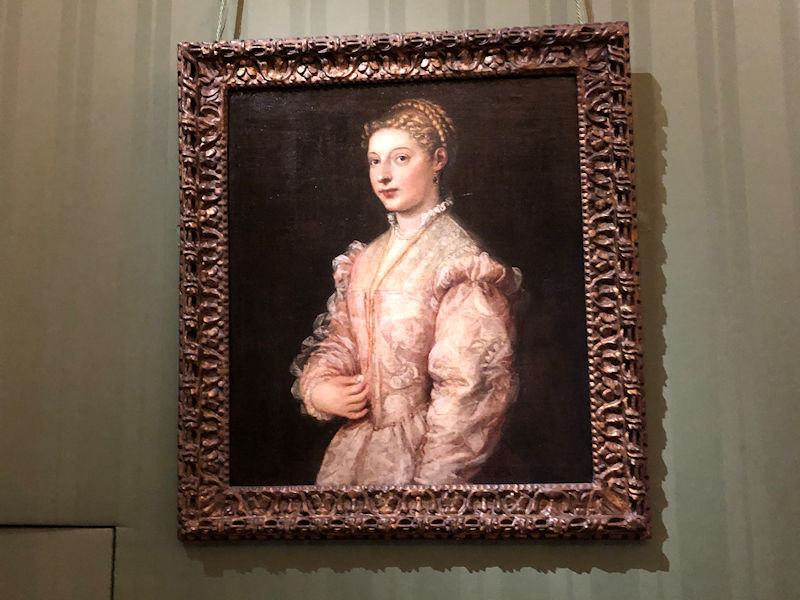
A portrait of a young woman, ca.1545, also by Titian

Here is a revision of Titian's 1531 'Penitent Magdalene', based on his 1565 version (now in the Hermitage in St Petersburg) and dated to 1567. He made several versions of this work to please insistent patrons, but it has been argued that this particular one was actually executed in 1547 for the Cardinal Alessandro Farnese.
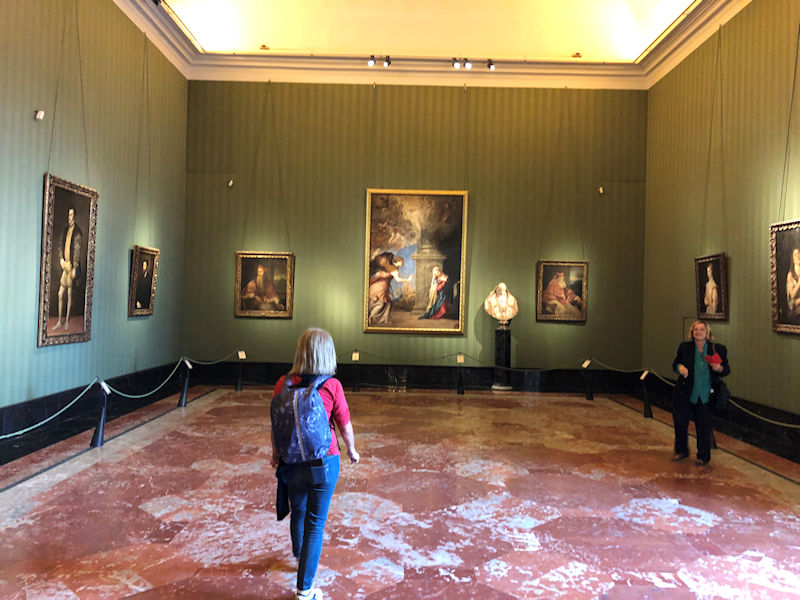
No crowding here
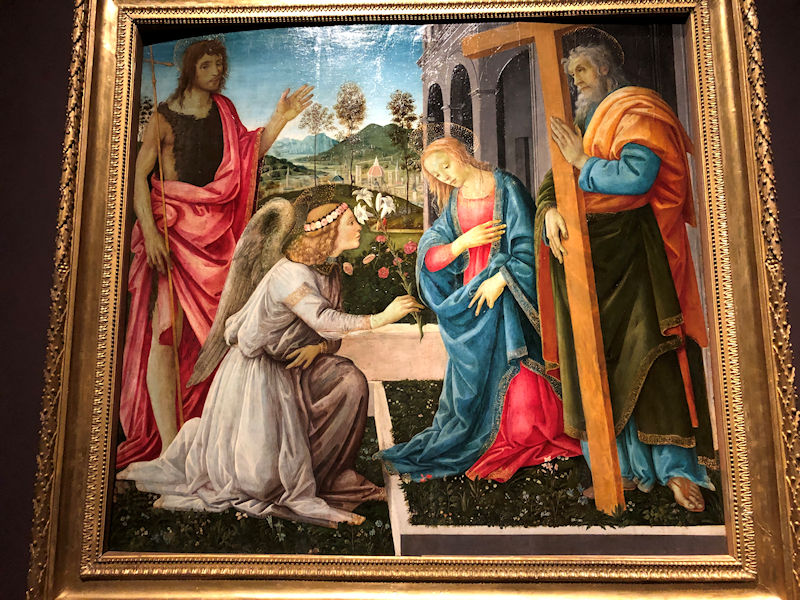
The Annunciation with John the Baptist and St Andrew -- a Botticelli sort of look to it, but it's by Filippino Lippi (ca.1457-1504), who got his start in Botticelli's workshop.
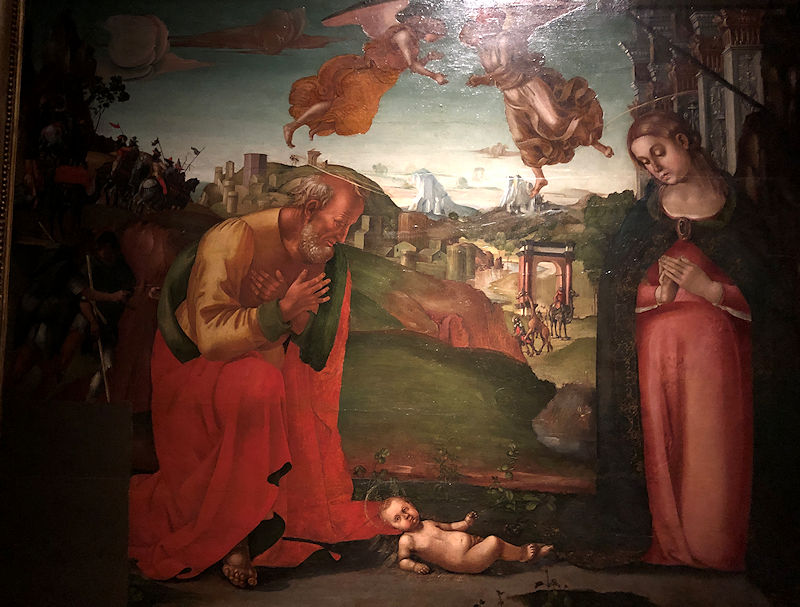
A rather grim and uninspiring Adoration of the Baby, by Luca Signorelli of Cortona (ca.1493-1496)
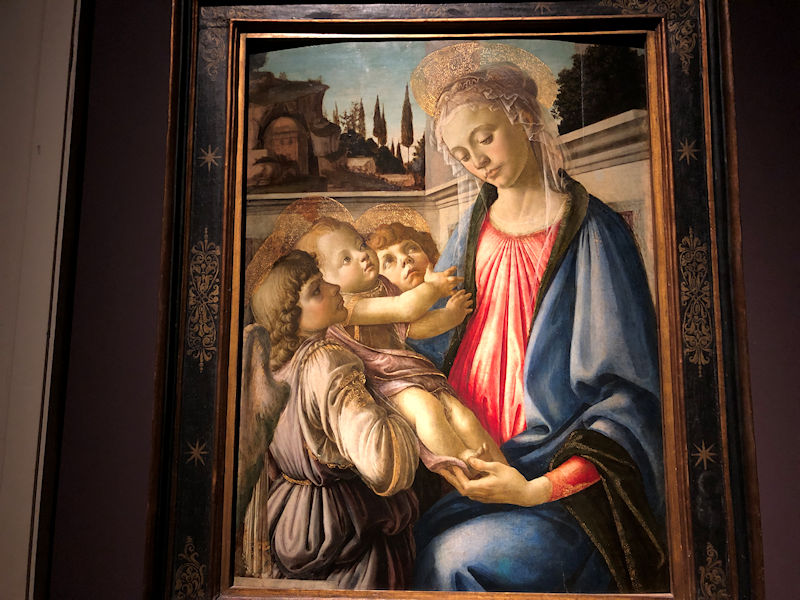
An unmistakably real Botticelli, Madonna and Baby and Two Angels, ca.1469 (restored in 2019)

Christ and the Woman Taken in Adultery, by the workshop of Lucas Cranach the Elder, dated as 'after 1537'
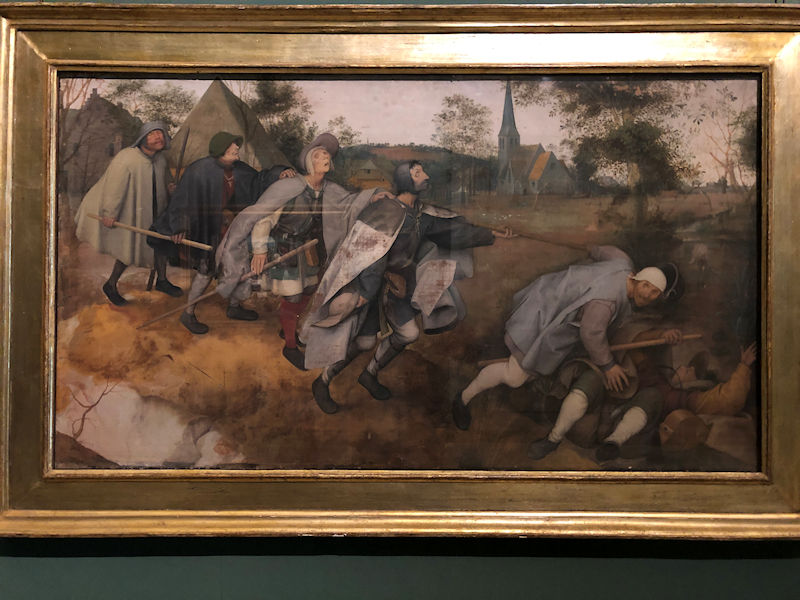
Brueghel the Elder's Blind Leading the Blind (La parabola dei ciechi), based on the parable referring to Pharisees in the gospel of Matthew, dated 1568
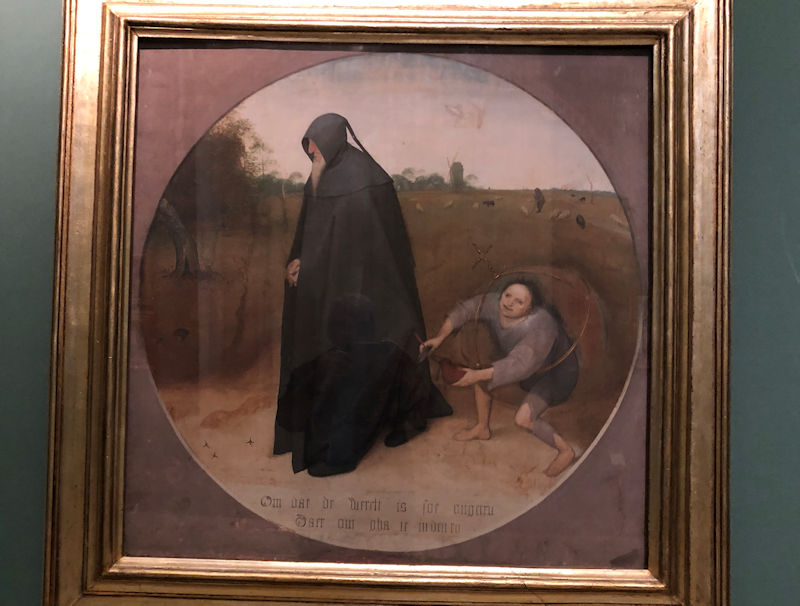
And the enigmatic Brueghel picture called The Misanthrope, 1568, cutting the old man's purse off. The text at the bottom has been translated as "Because the world is perfidious, I am going into mourning".

An elaborate Adoration of the Christ Child by Jacob Cornelisz van Oostsanen, 1512, one of several less crowded versions he'd made on the same theme.
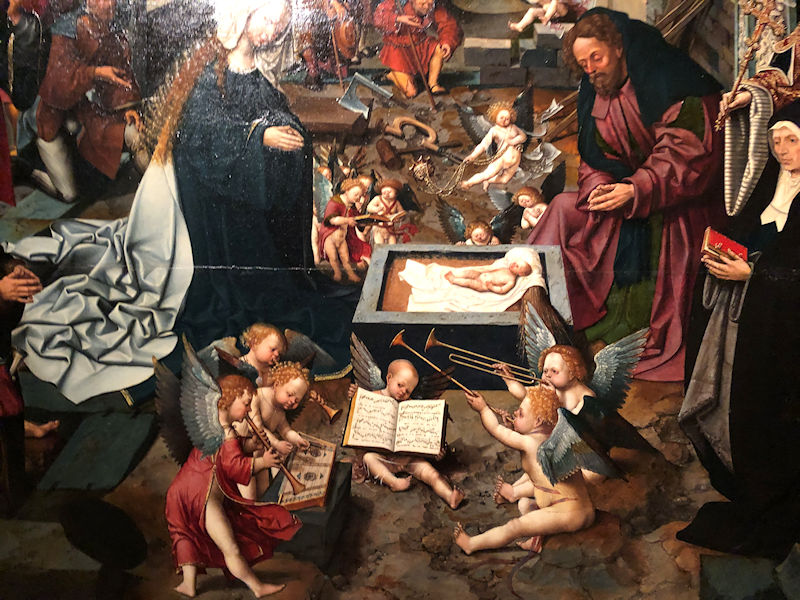
Detail: an emaciated Christ Child with a flight of fat little baby angels
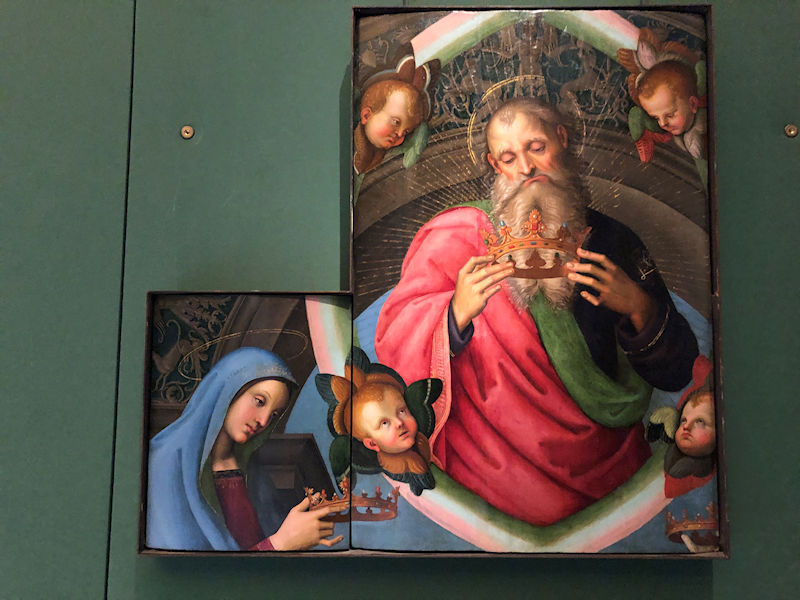
Fragments of an altarpiece: The Eternal Father Crowning the Virgin, by Raphael and Evangelista di Pian di Meleto, 1501
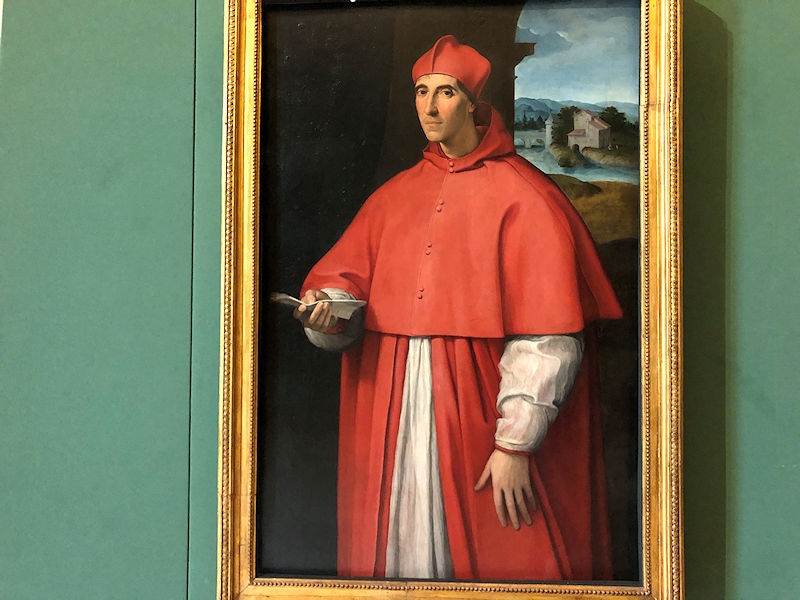
A portrait of Cardinal Alexander Farnese, later Pope Paul III, by Raphael, ca. 1509-1511

A copy by Andrea del Sarto (1523) of Raphael's Portrait of Pope Leo X with two Cardinals (ca. 1518-1520); the Cardinal on the left is understood to be Giulio de' Medici, soon to become Pope Clement VII (r. 1523-1534).

Raphael's Madonna of Divine Love -- Mary and Elizabeth with their kids (little John the future Baptist is genuflecting), ca. 1516-1518

On a related theme, an unimpressive Madonna and kids though it's by Giulio Romano of Mantua (1522-1523), a variation of a picture called 'La Perla' he'd made with his mentor Raphael in 1518. Similar, except that this one is called Madonna della Gatta, 'Madonna of the Cat', and . . .
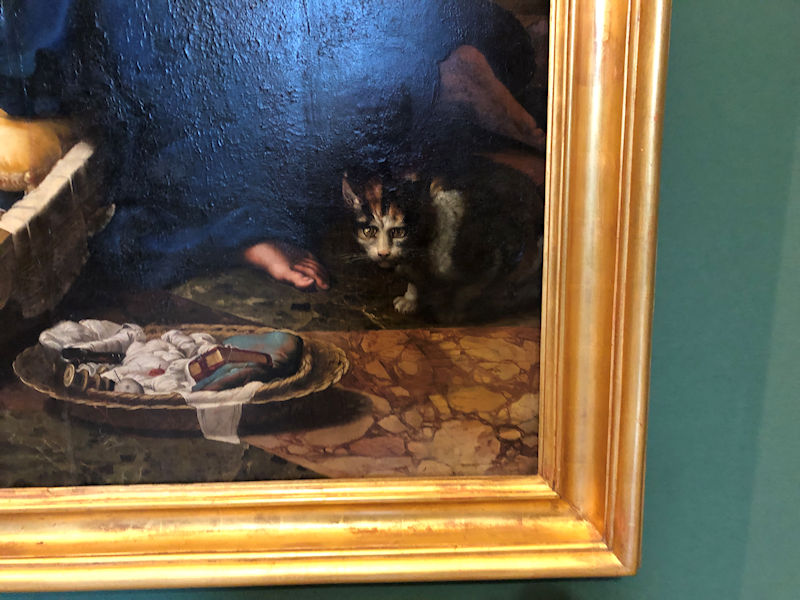
. . . there's the cat.
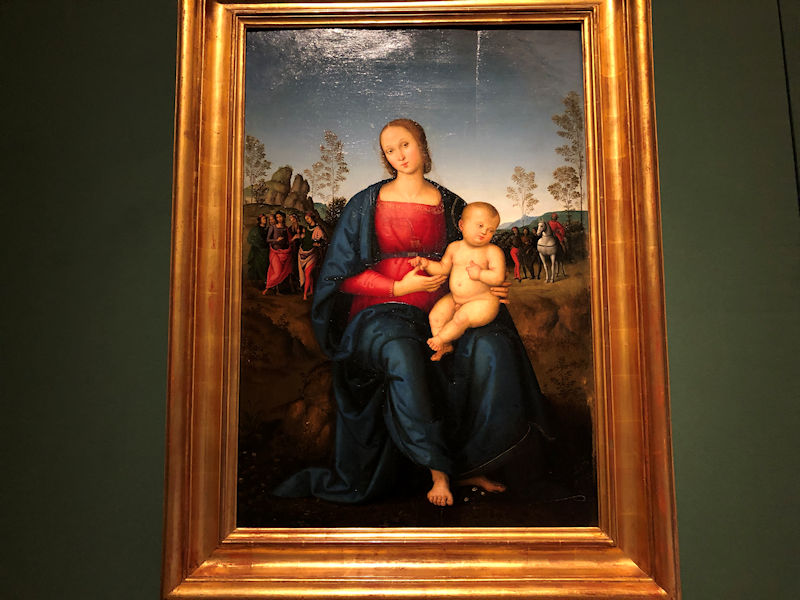
A fat-headed baby Christ and uninterested Madonna by Il Perugino, 1500
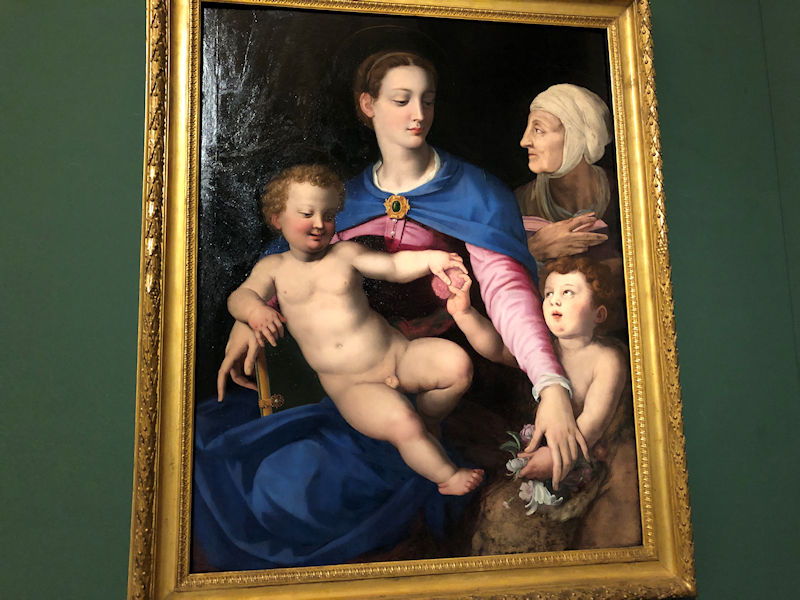
A striking Madonna with a much older looking Elizabeth, John the Baptist, and a curly-headed little mischief maker baby Jesus. By Il Bronzino, ca. 1560-1570.
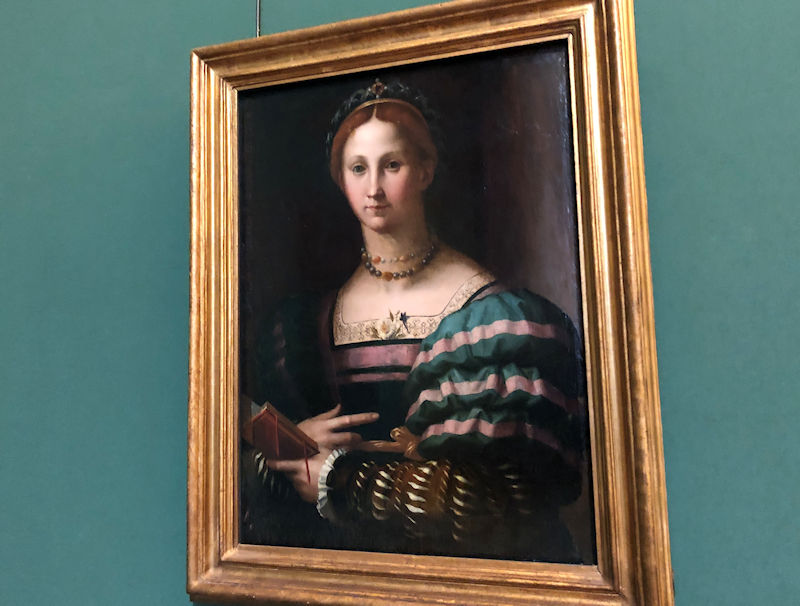
Another by Bronzino (Agnolo di Cosimo), an interesting Portrait of a Woman, 1550-1560

Madonna con Bambino e San Giovannino by Andrea Piccinelli, called Il Brescianino, with a distracted John the Baptist in his wildman clothes and anachronistic cross made of reeds
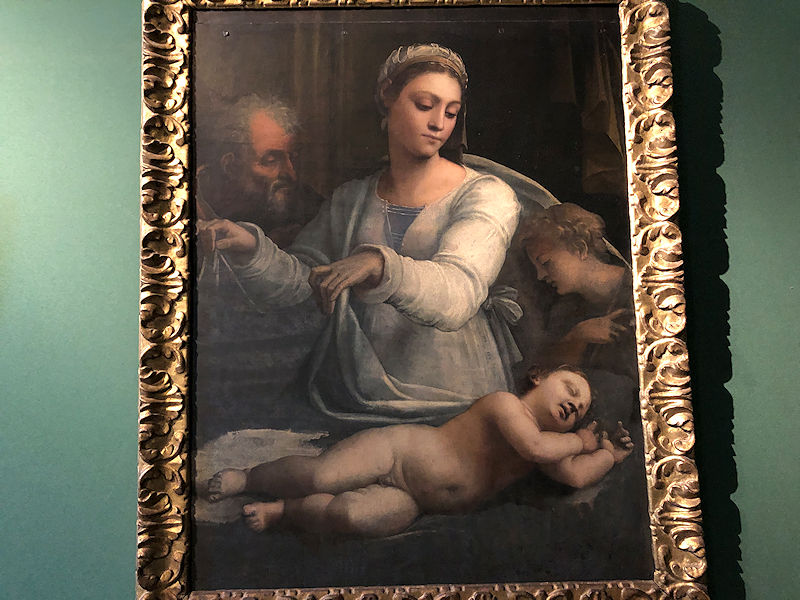
By Sebastiano del Piombo, in the Madonna of the Veil tradition, ca. 1530-1535
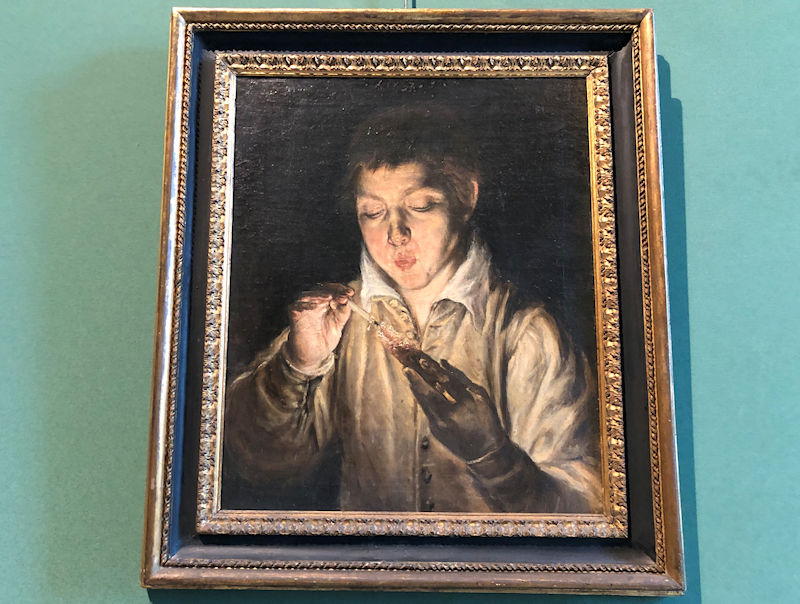
A kid trying to light a candle, surprisingly by El Greco, 1570-1572

This is labeled as by Nicolò dell'Abate, Portrait of a Boy with a Book (1545-1550), unless we've scrambled up our notes on it. But this isn't Nicolò's picture by that name, though it's got a book in it, and it's not altogether clear that that's really a boy. Impressive, though.
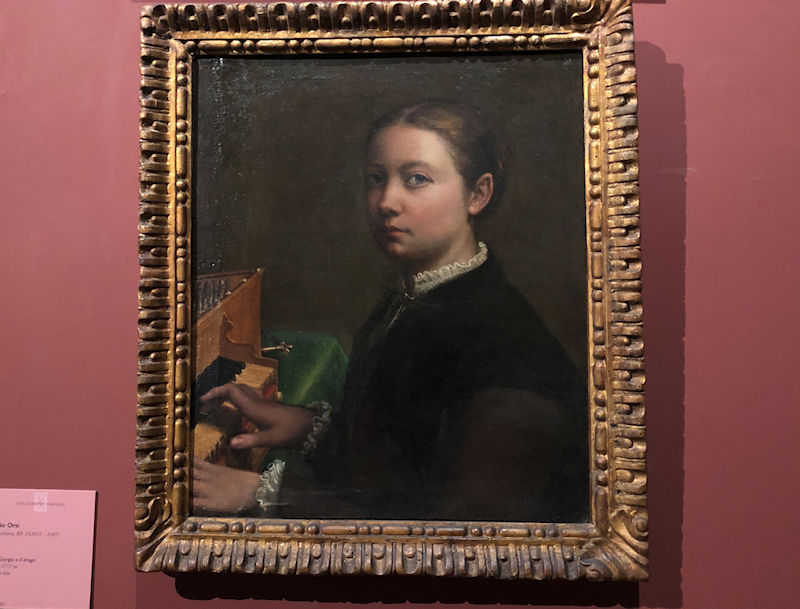
Here's a self-portrait of Sophonisba Anguissola of Cremona (ca.1532-1625), one of many self-portraits in fact; she was one of the first well-recognized female painters of the Renaissance era, knew Michaelangelo in Rome, etc., but was invited by Elizabeth of Valois, the wife of Philip II, King of Spain, to tutor her in Spain and soon became official court painter to the king. After the Queen's death in 1568, and married to a nobleman, she later lived in Genoa and Sicily and continued painting to an advanced age; Anthony Van Dyck visited her in Palermo in 1624, drew her portrait, and said that she taught him more about painting during their visit than anything else in his life.
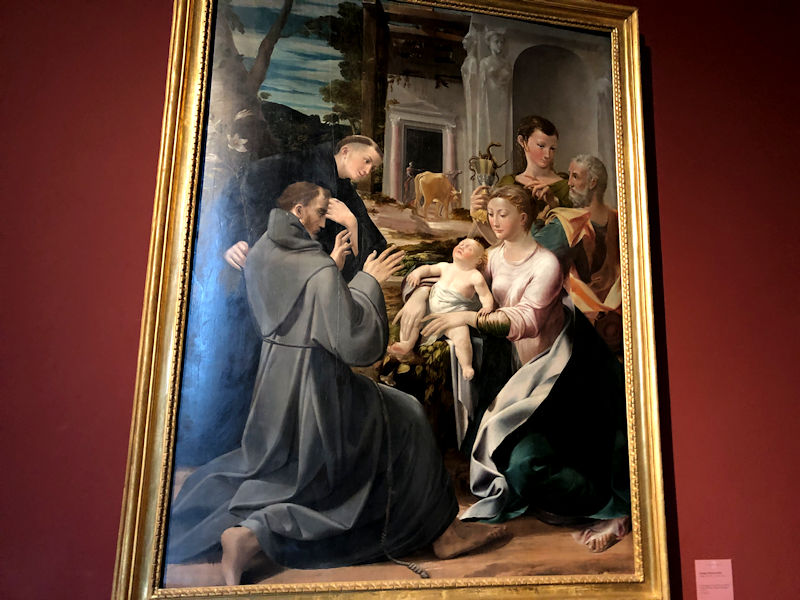
An odd sort of picture by Girolamo Mazzola Beduli (ca. 1500-1569), Madonna and Child with St Joseph, adored by St Anthony of Padua, St Francis of Assisi, and St John the Evangelist, 1537
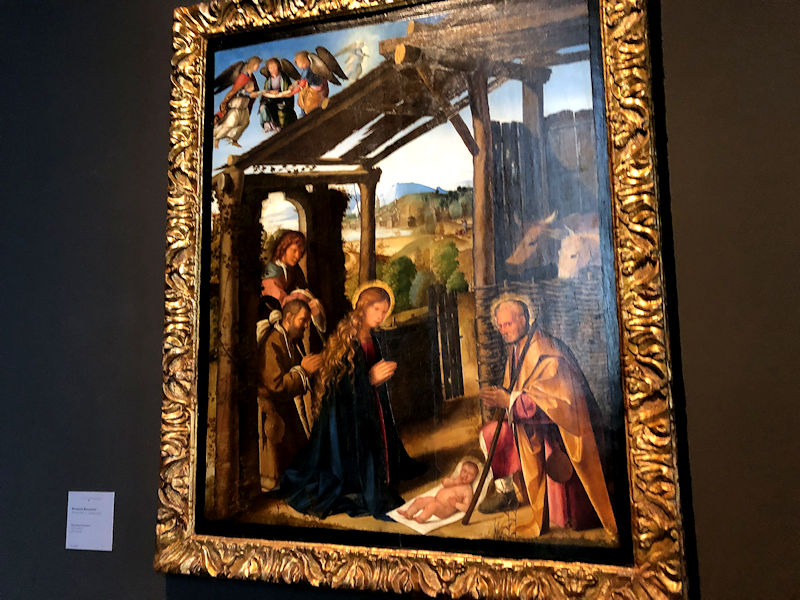
Boccaccio Boccaccino (ca. 1467-1525), Adoration of the Shepherds (1500-1507), with . . .

. . . a bewildered Baby Jesus.
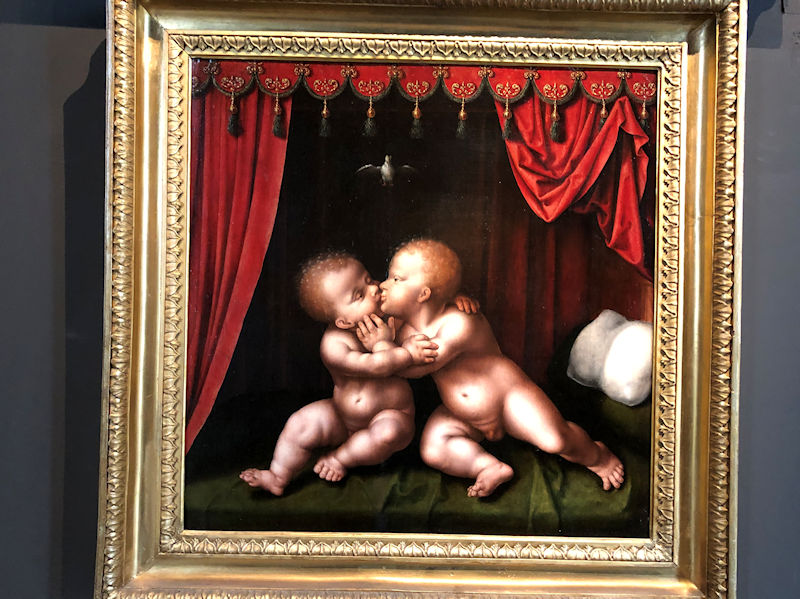
From the circle of Joos van Cleve (van der Becke) of Antwerp (ca. 1485-ca. 1540), a copy of a Leonardo da Vinci that ought to be entitled 'Don't Ask'.

Room to walk round, stretch your legs, meditate a little bit, and try to memorize the Farnese family tree mounted on the wall on the left.
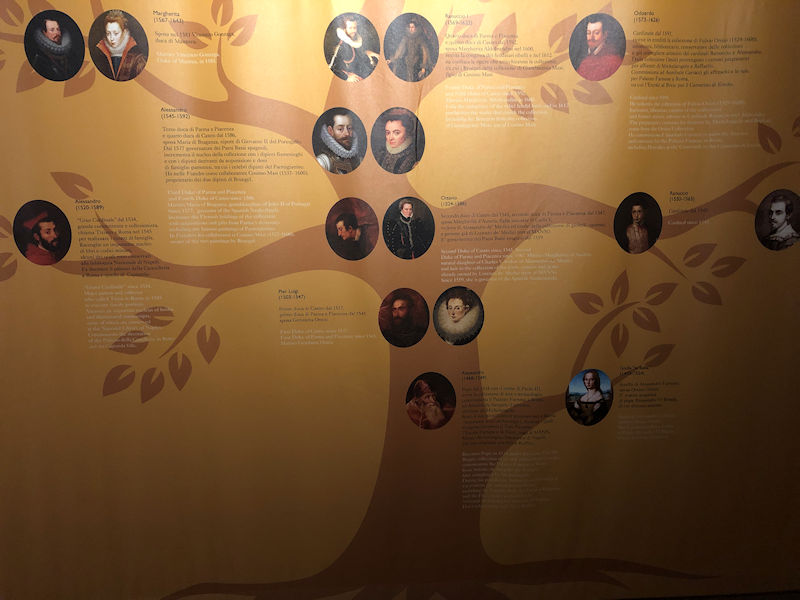
This is just a bit of it, starting at the bottom with Pope Paul III. The Farnese Dukes of Parma and Piacenza (with other titles) acquired an amazing collection of artworks, which when Elizabeth Farnese eventually became their last direct descendant and married King Philip V of Spain, her son Charles VII Bourbon, King of Naples (r. 1734-1759, later King Charles III of Spain), inherited the collection. His son, Ferdinand IV Bourbon, moved most of the collecton of artworks and classical statuary to the Bourbon palace in Naples.
To this day, the Pinacoteca in the Farnese Palace in Piacenza retains the ghosts of the missing works with prints in their place -- some of the rooms are distressingly made up of mostly place-holder prints in black and white.
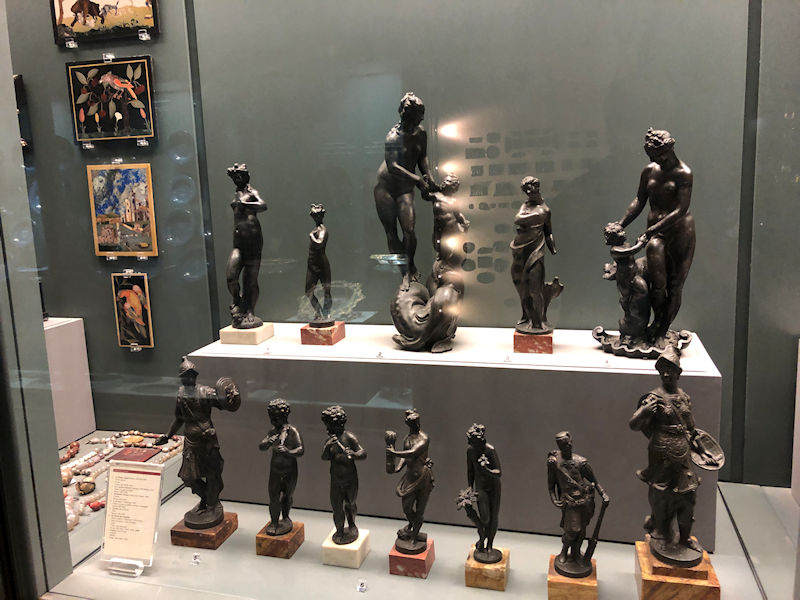
Little bronzes

A whole corridor full of six market and kitchen scenes by the wonderful Joachim Beuckelaer of Antwerp (1533-1574). This is likely the largest single collection of his work, we could suppose, though we've seen others elsewhere -- the Uffizi, the Louvre, the Prado [No Photo!!], the Palazzo Bianco in Genoa, the Château Rohan in Strasbourg, the Palazzo della Pilotta in Parma.

Given the lighting here, this series of photos didn't turn out very well . . .
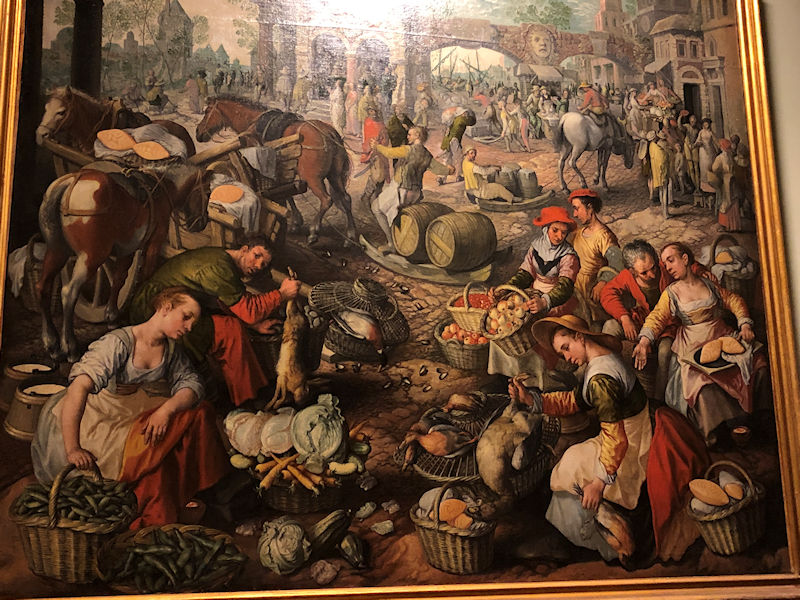
. . . but we've put together a webpage of somewhat better versions of the ones we've personally seen: it's here.
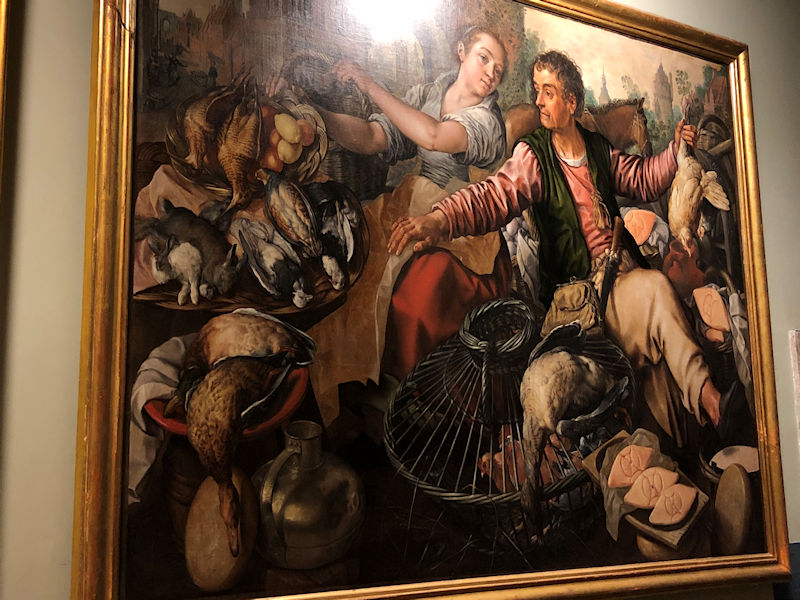
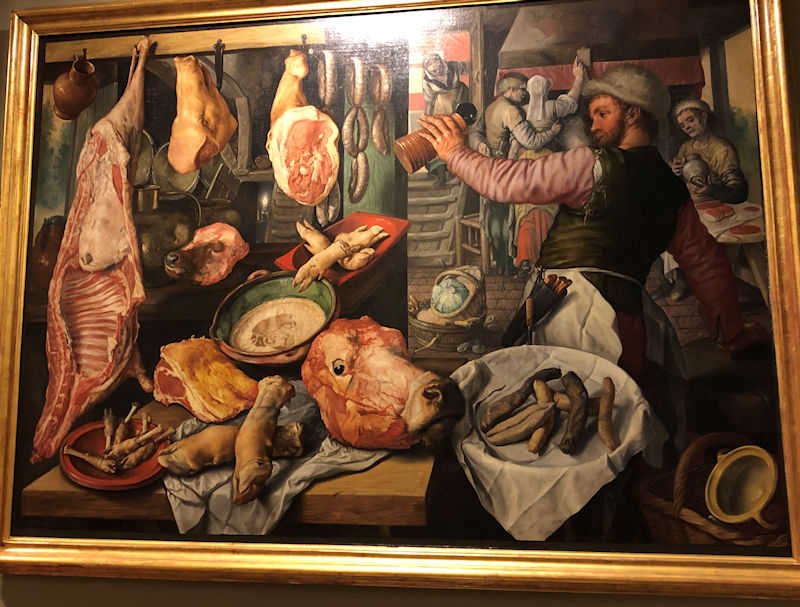
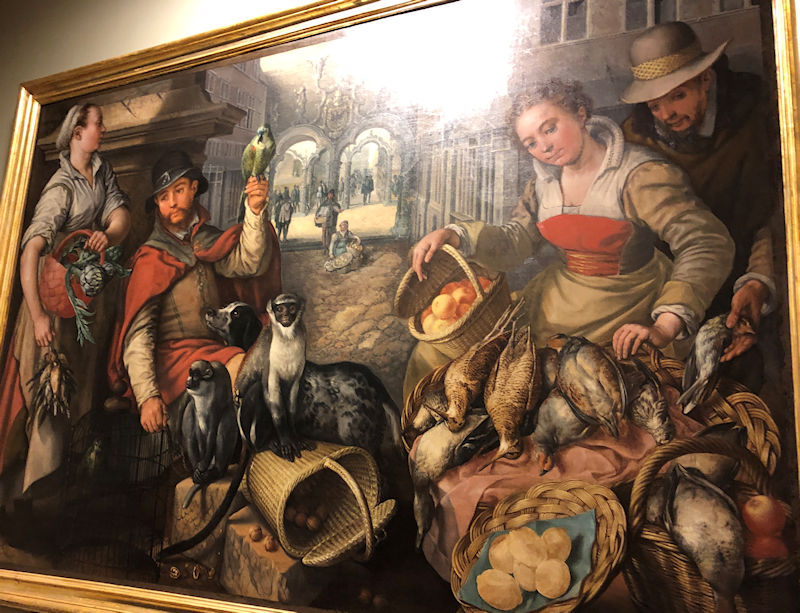
It's easy to believe that quite a few of these models appear in several pictures.
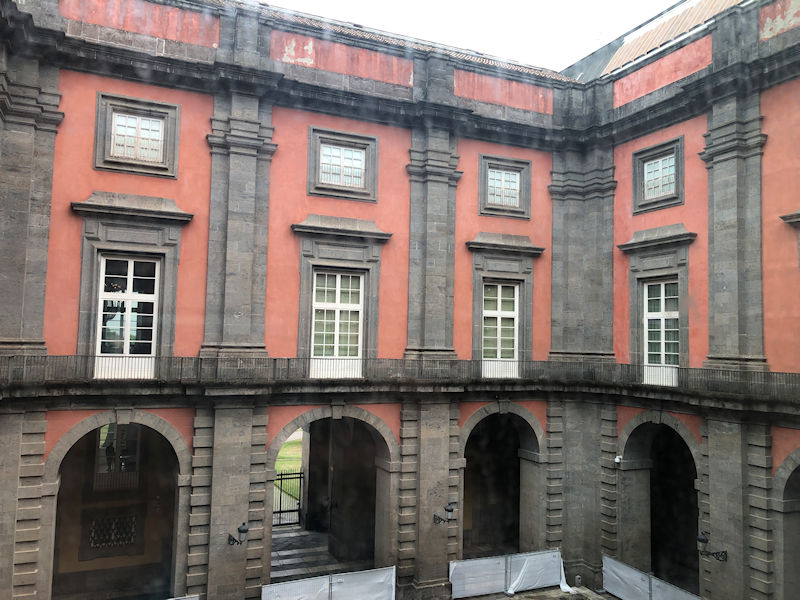
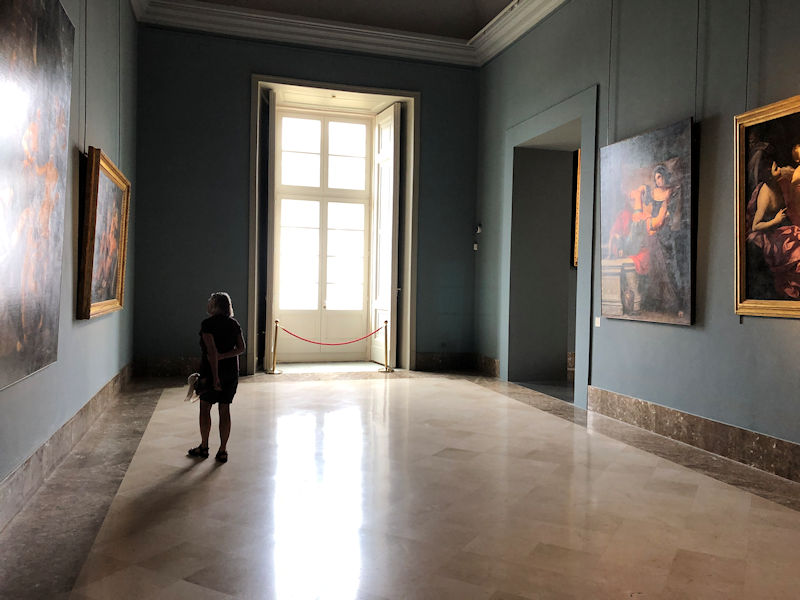
-- Feel free to walk around. Take your time. No hurry.

Le quattro stagioni (1615-ca. 1620), by one of the premier Baroque painters Guido Reni. 'He painted primarily religious works' (Wikipedia), but . . . he could be versatile.
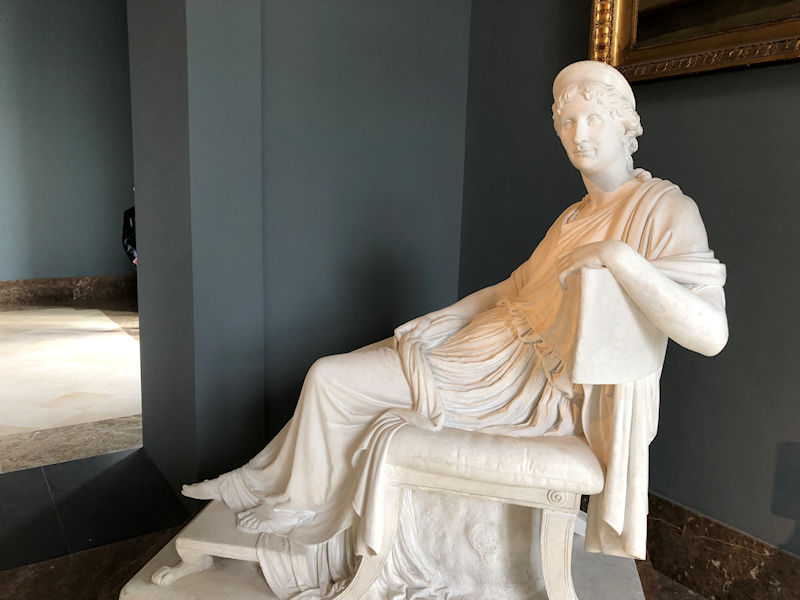
Canova's Letizia Ramolino Bonaparte (Napoleon's mum) (1804-1807)
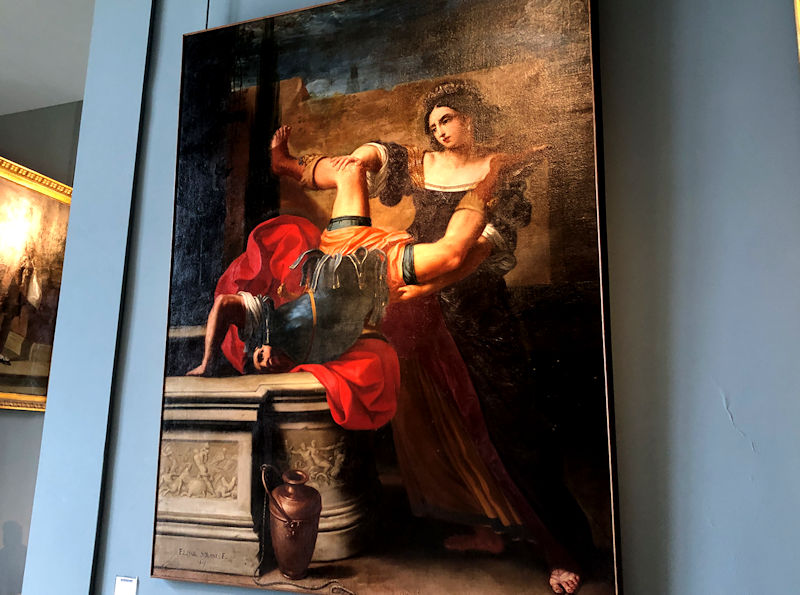
In the Artemisia Gentileschi vein, this is by another female artist who occasionally took things out on male subjects -- Elisabetta Sirani (1638-1665) was a daughter of a pupil of Guido Reni in Bologna (home of another female Bolognese artist, Lavinia Fontana, of the preceding generation). In addition to her own works, she established 'the first school of painting for women in Europe outside of a convent, and it was inclusive regardless of the women's artistic and social connections' (Wikipedia). She died fairly young in what were then considered suspicious circumstances, but which are now considered to have been a medical problem.
This is 'Timoclea Kills the Captain of Alexander the Great', with a look of workmanlike efficiency (1659). According to Plutarch, the Thracian captain raped Timoclea of Thebes, then asked her where the family's money was hidden; she told him that it was hidden in the well. Whoops.
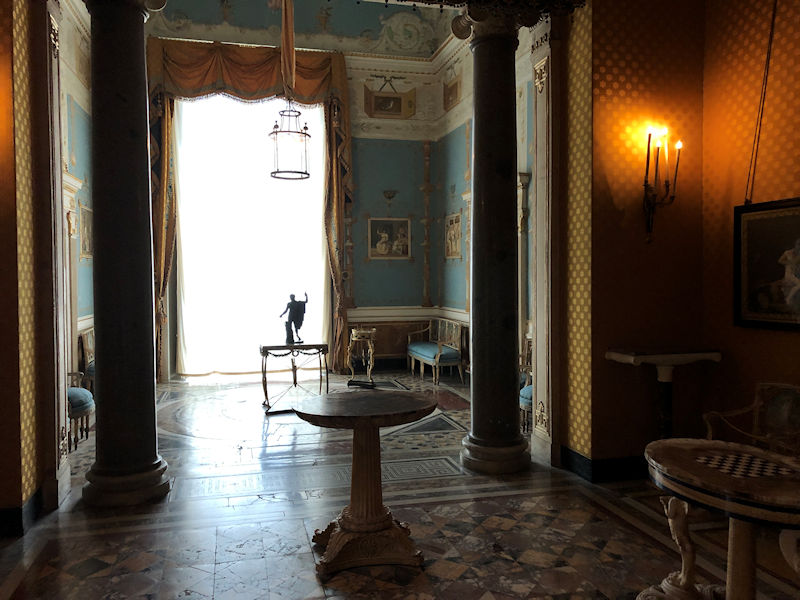
The palace has lots of rooms recreating how they must have looked back in the day.
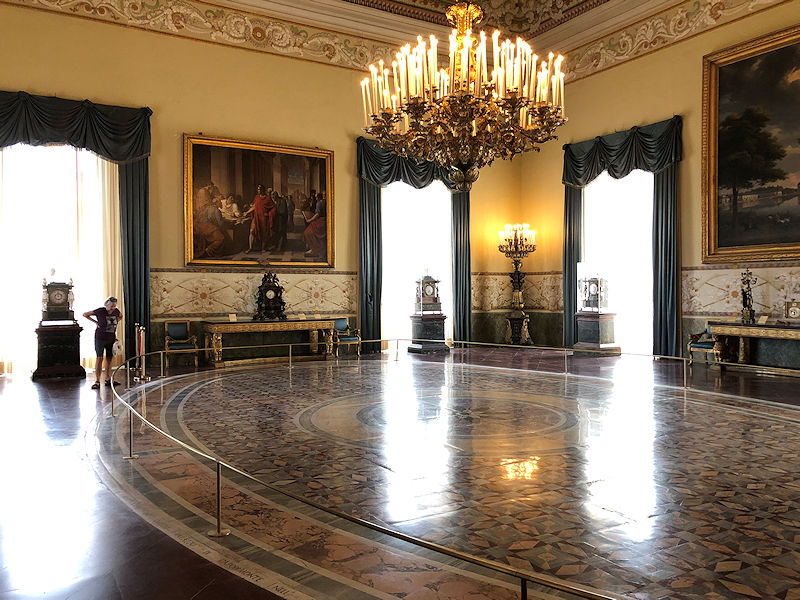
Like this enormous party venue

Apparently this is how 'the other half' lived -- banged up in a gaudy mobile prison cell for transport round the city on other people's shoulders.
(Many of the very rich people nowadays might likely get stuck in one of those and need the 'jaws of life' to get them out.)
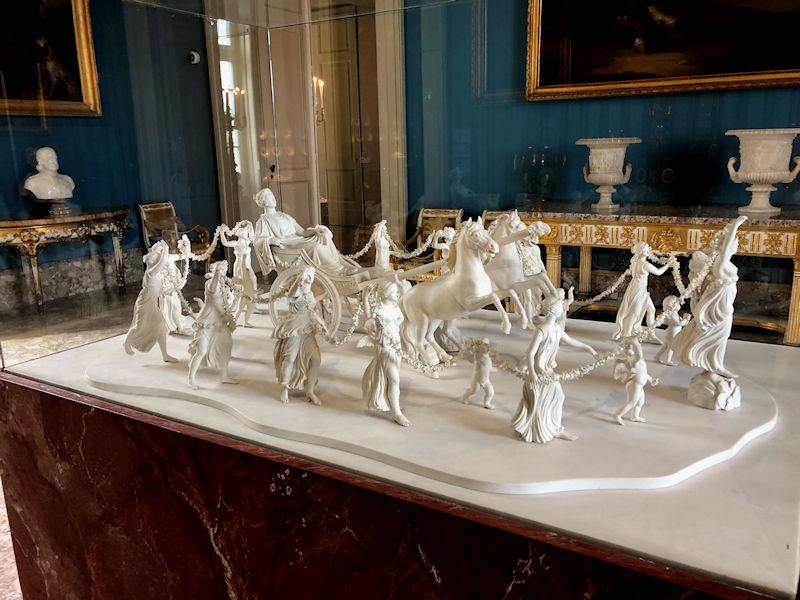
Not a stocking stuffer
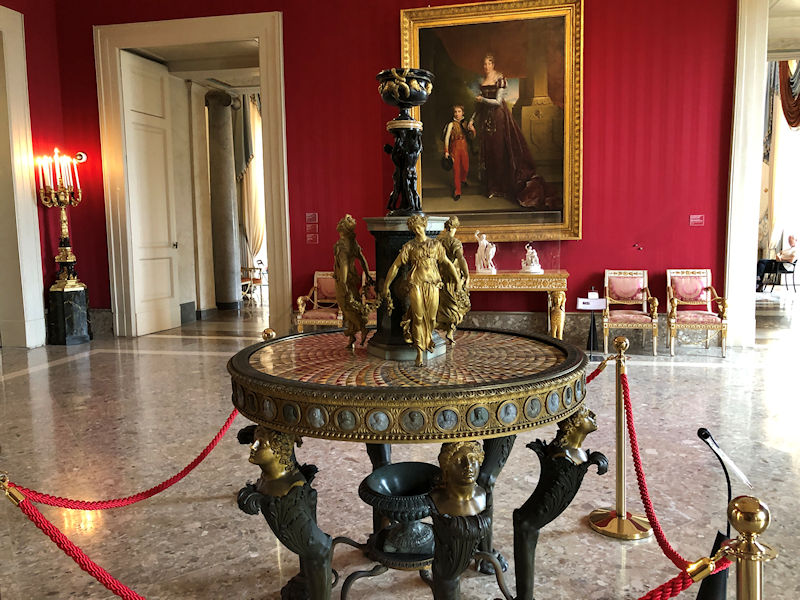
Perhaps it once had an obvious purpose, but one can only speculate. The table legs are very strange. Described as 'Manifattura Napoletana', 1815-1825.
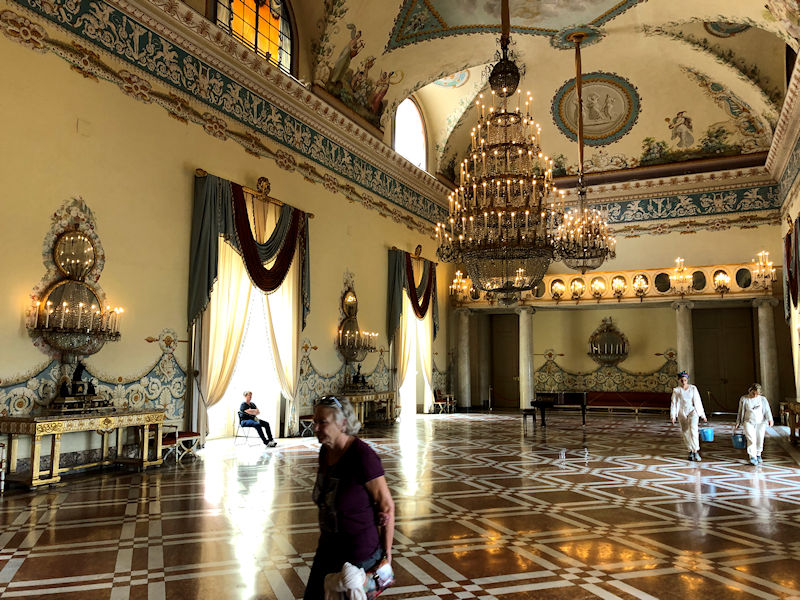
Another party venue -- surely they must have been fairly awkward affairs: overdressed, caste-conscious, envious or on the other hand arrogant, possibly not well bathed . . . an 18th century form of mosh pit.
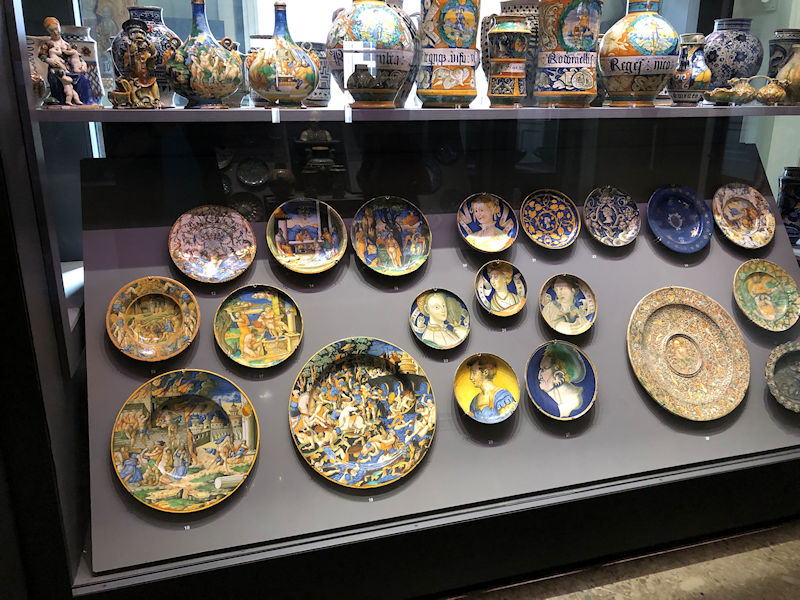
Majolica
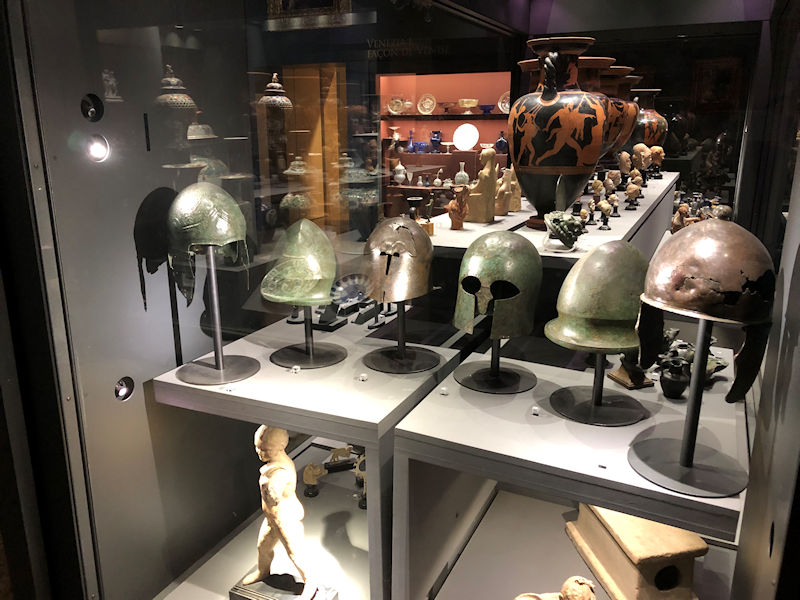
Ancient helmets, some fairly improbable
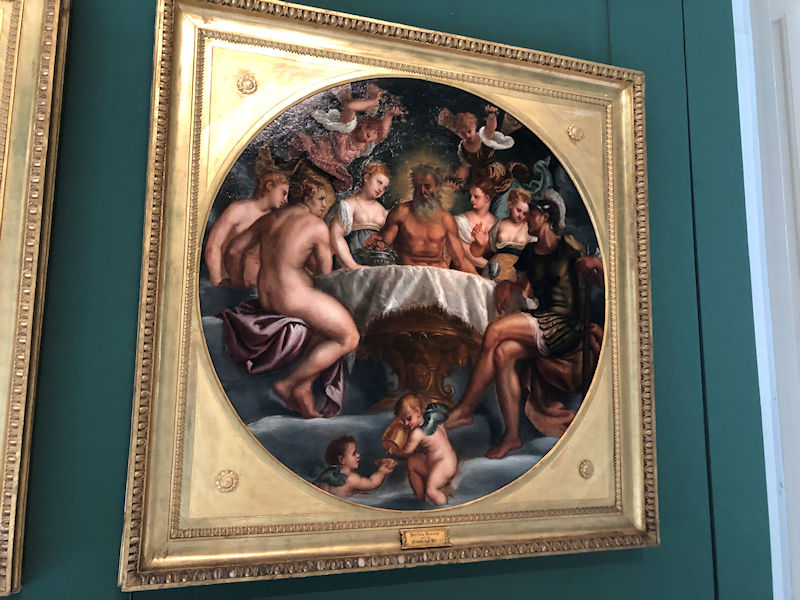
On a parting note, The Banquet of the Gods (ca.1540), by Polidoro de Renzi 'da Lanciano' (ca.1510-1565)
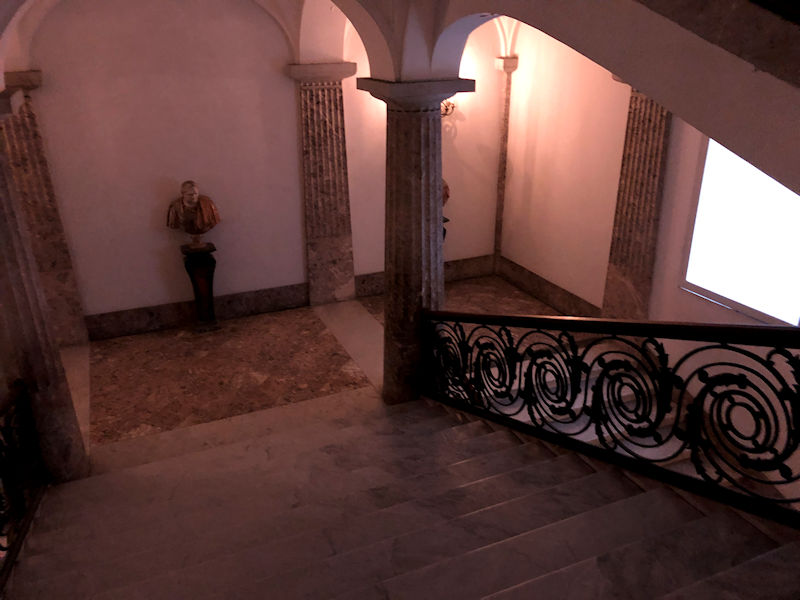
There's plenty more here . . . we haven't even come to the rooms we visited in our previous trip . . . but we're committed to walking home down the mountain, and it's time to get started.

Down we go. And with no railings for the older clientele to hang onto.
Next up: Neapolitan street scenes


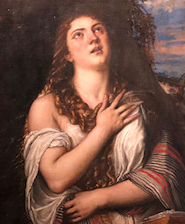 Dwight Peck's personal website
Dwight Peck's personal website
















































































